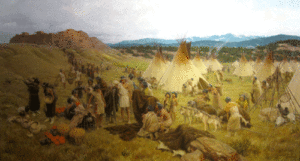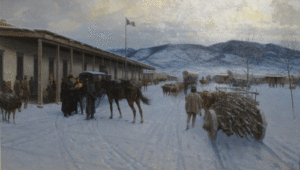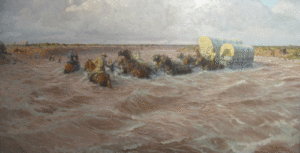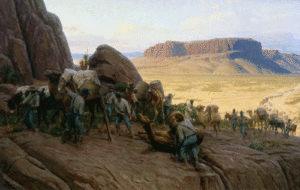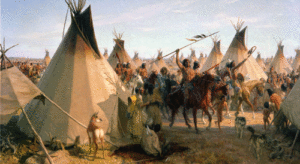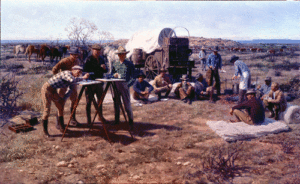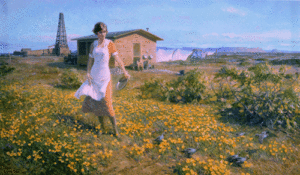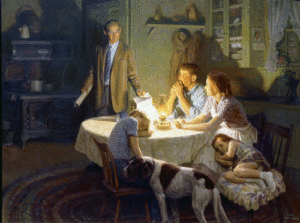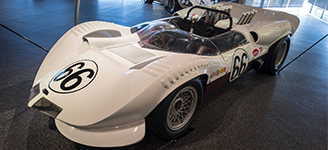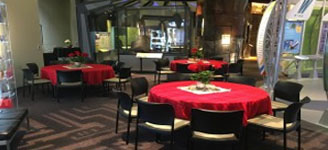Tom Lovell “Mini” Paintings Tour
Trading at the Pecos Pueblo
Oil on Canvas, 35 ½ ” x 62 ½ ” A peaceful trading scene between the permanently-settled Pueblos and a group of visiting Jicarilla Apaches, camped in buffalo-hide tepees at the foot of the mesilla, just beyond patches of standing corn.
Governor’s Palace, Santa Fe
Oil on Canvas, 36″ x 63″ In the bleak cold of early 1846, at the corner of the palace already more than two centuries old, Mexican Governor Manuel Armijo stands in the snow at dusk and, by lantern light, reads a dispatch just bought by horseback courier. It is the twilight time of the Mexican reign of Santa Fe, and, no doubt, the news is not good.
Horsehead Crossing on the Pecos River
Oil on Canvas, 30 3/4″ x 59″ Horsehead Crossing was the most famous of the fords along the Pecos River from New Mexico to its junction with the Rio Grande. This painting depicts an 1850 crossing described by John R. Bartlett, mapping the region for the U.S.-Mexico Boundary Commission. One views a state of near panic as one wagon attempts to pass another which brings the mules to confusion and alarm.
Camels in Texas
Oil on Canvas, 37″ x 57″ Camels arrived in Texas in 1856, a noble dream-come-true of Secretary of War Jefferson Davis. The painting is based on an actual happening in June, 1859, while the camels were being tested against the most brutal of terrain in southwest Texas. One of the camels working its way up a sloping bare rock lost its footing and fell, smashing a water barrel in a land where water was precious almost beyond measure. One of the officers quickly cut the line and prevented a bad situation from becoming worse.
Comanche Moon
Oil on Canvas, 35 ½” x 63″ By the time the white man began to visit the Permian Basin in significant numbers, the dominate Indian tribe was the warlike Comanche. This Lovell painting depicts the triumphant return of a Comanche-Kiowa raiding party from its annual trip to the interior of Mexico to its village near present Ft. Stockton. The warriors have painted and decorated themselves and their horses for the grand entry into their village.
Free Lunch on the Slaughter Ranch
Oil on Canvas, 34 3/4″ x 56 3/4″ J. A. Slaughter operated the large and historic U Lazy S Ranch in Garza County of West Texas. This Lovell painting is set in 1924 and depicts a hypothetical gathering of men prominent in the development of Permian Basin oil and gas production. Slaughter invited these geologists to his ranch to enjoy a chuck wagon dinner, hoping they might find inspiration to explore the drilling possibilities on his ranch.
Bride’s Home at a Wildcat Well
Oil on Canvas, 21 ½” x 36 ½” Like pioneer women for generations before them, wives of the early oil men followed their husbands into sometimes desolate environments, yet managed somehow to make a home. Lovell’s painting celebrates the resilient spirit o f these women. The setting is a wildcat driller’s camp. The young bride has finished her morning wash and has walked out into her vast open “yard” with tin plate in hand to feed her flock of “chickens,” a covey of blue quail.
A Trade at Midnight
Oil on Canvas, 35 ½” x 45 ½ It was the responsibility of the landman to negotiate with owners of the mineral rights for authority to explore for oil and gas. This scene that Lovell painted was based on an actual event described to him by George T. Abell, an independent operator in the Basin’s development. It is near midnight and the futures of the farm family and of the oil man hang in the balance. The landman is offering the farmers money from the oil lease and the farmer is considering the risks and the benefits. A decision must be made.


